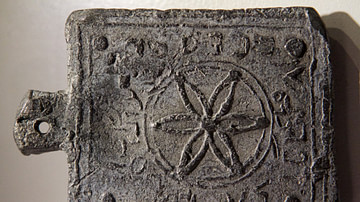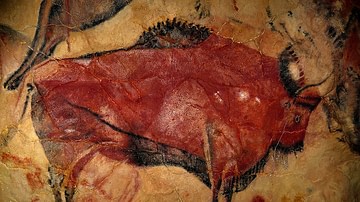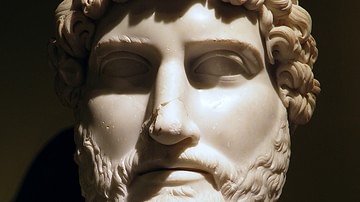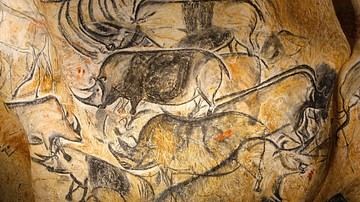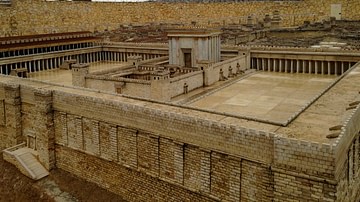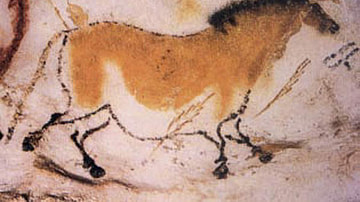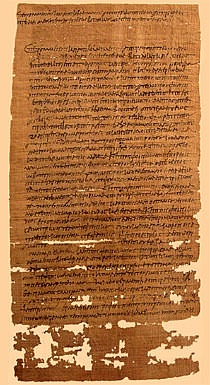
Everyone is aware of the Dead Sea Scrolls, but few realise that these were just one find in a region which continues to yield hundreds of finds significant to our understanding of lives in the first centuries CE, the Jewish revolts and the relationships between the peoples involved in the area. The Cave of Letters is one such site in Israel which has yielded a large number of papyrus letters and documents.
Discovery
The Cave of Letters was discovered in Israel in the early 1960s CE and was excavated by the famed Israeli archaeologist Yigael Yadin from 1960-1961 CE. Yadin devoted himself to research and archaeology upon leaving the military and received the Israel Prize in Jewish studies for his doctoral thesis on the translation of the Dead Sea scrolls. Apart from the Cave of Letters, Yadin excavated numerous important sites in the region which included Tel Megiddo, Masada, the Qumran Caves and Hazor. Yadin discovered the cave when he launched an urgent search of the dead sea caves in order to rescue artefacts of historical significance before they were looted by increasing numbers of treasure hunters in the region. The cave may be one of the 64 locations which were inscribed on a copper scroll found in another cave near the Dead Sea village of Qumran. This is believed to be due to the similarities in location and shape of the cave entrances as two columns in addition to the placement of bronze artefacts and stone vessels in the cave, which are also mentioned on the scroll.
Archaeological Excavations
The Cave of Letters was found above a canyon called Nahal Hever. The cave is located in the area of the Dead Sea in the Judean desert and can only be assessed via a 50 ft (15.24 m) climb up to the cave's entrance. During the 1960-61 CE excavations, Yadin uncovered a number of human skulls and bones and common objects of daily life alongside what he believed to be bronze ritual items. Yadin's team also uncovered clusters of papyrus letters which made up the largest cache of ancient personal correspondence and documents ever found in Israel. These letters are slowly being published, a process yet to be completed. Among the letters include correspondence from Bar Kochba, a messianic leader of the third Jewish revolt against the Romans in the second century CE. Judea was part of the Roman empire but the Jewish people lived uncomfortably with their Roman rulers as a subject nation. Among the documents in the Cave of Letters were found military orders signed by Bar Kochba as Shimon Bar Kochba, Simon son of a star.
Contents of the Letters
Surprisingly to some scholars the letters have quite a harsh tone and include threatening letters to Yehonatan who was the leader of En Geddi. In 2000-2001 CE the archaeologist and Professor of Jewish History, Richard Freund, from the University of Hartford, led a team under the John and Carol Merrill Expedition to find out more about the Cave of Letters. On returning to the cave with an international team of archaeologists and scholars, Freund uncovered new evidence about the use of the cave and located a large number of new artefacts. Freund explains that the Cave of Letters is a massive cave with two openings in the sheer cliff wall with three internal chambers connected by narrow passageways with the cavern complex cutting more than 300 yards (274 m) deep into the cliff-side. Freund had the chance to explore new areas to excavate which Yadin did not get a chance to. Yadin was unable to explore beneath the thick layer of rubble on the cave floor caused by centuries of earthquakes. In some areas the rubble was as thick at 15ft (4.57 m). Freund also had access to ground-penetrating radar and electrical resistivity tomography which allowed him to excavate and survey beyond Yadin's means. Freund and Yadin's excavations turned up artefacts that are significant to the history of the relationship between Judaism and Christianity and the politics of the modern Middle East.
One of the most significant corpuses of letters found in the cave are the personal documents of a Jewish woman who lived in the port town of Maoza. This woman was named Babatha. The documents give a vivid picture of the life of an upper-middle class Jewish woman during the second century CE. They date from around 96-134 CE and give examples of Roman bureaucracy and legal systems by including legal contracts concerning marriage, property transfers and guardianship. They show that Babatha was born around 104 CE and inherited her father's date palm orchard. She married for the first time in 124 CE and was widowed with a son named Jesus. She remarried in 125 CE to a man named Judah who already had another wife and a teenage daughter. There are also loan documents showing that Judah borrowed money from Babatha who was clearly in control of her own money. She got this money back upon Judah's death in the form of his estates. Other documents in the Babatha archive include those concerning the guardianship of her son and a dispute between her and Judah's first wife Miriam over Judah's estates.
Use of the Cave
The use of the Cave of Letters is still under some debate but the artefacts are revealing. The most common theory is that the cave was used as a hideaway by Jewish refugees who were escaping oppressive Roman rule. Babatha would have been in the area in 132 CE at the time of the Bar-Kochba Revolt. It is possibly that she fled or was killed as the documents in the cave were never recovered and were found alongside 20 skeletons which suggest that she or others perished while taking refuge in the cave. What is interesting about the skeletal remains is the complete lack of signs for violent trauma suggesting that they died of starvation. The cave being used as a refuge is also suggested by signs of animals and cooking preparations including a piece of a circular oven. Freund found a number of items indicative of everyday life including rope and papyrus fragments, fabrics, a wooden comb, signs of living areas and a child's sandal. The sandal is particularly significant because evidence of women and children in the area is rare.
The Cave of Letters also provides direct evidence of Bar Kochba's early triumphs supposedly with a Bar Kochba coin found in the A-B passage. This is one of eight coins found in the cave. The inscription on the coin reads 'for the freedom of Jerusalem'. Clearly the Cave of Letters is a trove of information and significance.
